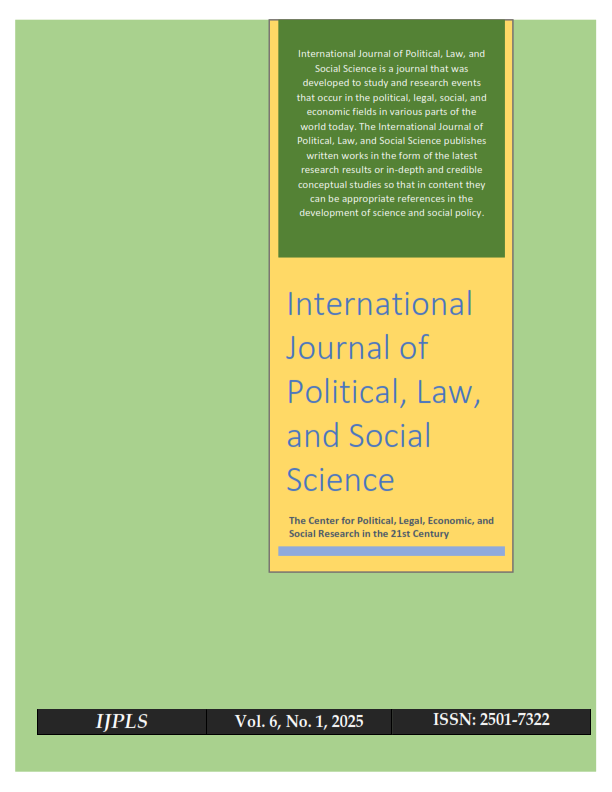INFRASTRUCTURE DEVELOPMENT POTENTIAL AND POLICY IN TABALONG REGENCY AS A SUPPORTING REGION FOR THE NATIONAL CAPITAL
Keywords:
New Capital City, Policy Strategy, Regional Development Potential, TabalongAbstract
The relocation of Indonesia’s capital city is a strategic governmental initiative aimed at improving urban governance and promoting equitable national development. Geographically, the new capital located in the central region of Indonesia, specifically in Penajam Paser Utara (PPU) and Kutai Kartanegara (KuKar) Regencies is expected to accelerate economic distribution, particularly in the eastern part of the country. Infrastructure development associated with this relocation will also significantly impact surrounding regions, including South Kalimantan, which is projected to serve as a supporting area for the new capital. Tabalong Regency, situated strategically in South Kalimantan, has formulated various strategies and policies to anticipate and align with the development of the new capital, positioning itself as the southern gateway to Nusantara. Using a qualitative research approach, this study reveals that Tabalong possesses multiple strengths, including natural resources, a strategic location, infrastructure, tourism potential, and cultural diversity. In preparation for the capital relocation, the local government is implementing key policies focused on infrastructure enhancement, economic and industrial development, community empowerment, environmental management, digital connectivity, and the creative economy.
References
Andrianto, A., Udiansyah, U., & Yunani, A. (2024). Effects of road and bridge infrastructure development on the local economy in Tabalong Regency. Pancasila International Journal of Applied Social Science, 2(3), 333–346. https://doi.org/10.59653/pancasila.v2i03.1034
Anggiani, I., Tasha, N., & Munawaroh, R. (2021). Infrastruktur dan pertumbuhan ekonomi daerah: Analisis kontribusi sektor publik. Jurnal Ekonomi dan Pembangunan Indonesia, 22(1), 45–58. https://doi.org/10.21002/jepi.v22i1.2021.003
Bappenas. (2020). Kajian Pemindahan Ibu Kota Negara. Kementerian PPN/Bappenas. https://ikn.go.id
Basrowi. (2008). Memahami Penelitian Kualitatif. Jakarta: Rineka Cipta.
Creswell, J. W., & Poth, C. N. (2018). Qualitative Inquiry and Research Design: Choosing Among Five Approaches (4th ed.). SAGE Publications.
Denzin, N. K., & Lincoln, Y. S. (2011). The SAGE Handbook of Qualitative Research (4th ed.). SAGE.
Diskominfo Tabalong. (2023). Tabalong serambi depan Kalsel penyangga IKN. Dinas Komunikasi dan Informatika Kabupaten Tabalong. https://diskominfo.tabalongkab.go.id/wp-content/uploads/2023/01/TABALONG-SERAMBI-DEPAN-KALSEL-PENYANGGA-IKN.pdf
Haryanto, T. (2022). Infrastruktur dan keseimbangan pembangunan antarwilayah di Indonesia Timur. Jurnal Borneo Administrator, 18(2), 125–138. https://doi.org/10.24258/jba.v18i2.2022.213
Indonesia Business Post. (2024, August 5). Tabalong regency ready to be a “support city” for IKN. Indonesia Business Post. https://indonesiabusinesspost.com/1935/Politics/tabalong-regency-ready-to-be-a-support-city-for-ikn
Izzati, N. (2023). Multiplier effect of Riam Bidadari tourism village on economic growth of Tabalong Regency. International Journal of Social Sciences, 6(1), 45–57.
Miles, M. B., & Huberman, A. M. (1994). Qualitative Data Analysis: An Expanded Sourcebook. Thousand Oaks: SAGE.
Neuman, W. L. (2014). Social Research Methods: Qualitative and Quantitative Approaches (7th ed.). Pearson.
Nugroho, Y., & Pratama, M. R. (2022). Smart city implementation and regional competitiveness: Evidence from Indonesian local governments. Journal of Public Administration and Governance, 12(4), 87–102. https://doi.org/10.5296/jpag.v12i4.20345
Palinkas, L. A., Horwitz, S. M., Green, C. A., Wisdom, J. P., Duan, N., & Hoagwood, K. (2015). Purposeful sampling for qualitative data collection and analysis in mixed method implementation research. Administration and Policy in Mental Health and Mental Health Services Research, 42(5), 533–544. https://doi.org/10.1007/s10488-013-0528-y
Patton, M. Q. (2002). Qualitative Research & Evaluation Methods (3rd ed.). SAGE Publications.
Pramesti, N. P., & Basuki, I. (2025). Challenges and opportunities in managing large-scale infrastructure projects: The case of Indonesia’s new capital Nusantara. ResearchGate. https://www.researchgate.net/publication/393487030
Pusat Komunikasi Publik. (2022). Laporan Tahunan Pembangunan Infrastruktur Nasional. Kementerian PUPR.
Putra, H. A., & Santoso, R. (2021). Infrastructure connectivity and regional economic diversification in resource-based areas. Journal of Regional Development Policy, 5(1), 45–59. https://doi.org/10.32698/jrdp5159
Rifani, M. N. (2021). Konektivitas regional Tabalong sebagai penyangga IKN: Analisis potensi transportasi dan logistik. Laporan Penelitian Bappeda Tabalong.
Rosyadi, S., & Sobari, A. (2020). Economic diversification in resource-dependent regions: Lessons from Indonesian provinces. Jurnal Ekonomi dan Pembangunan, 28(2), 129–142. https://doi.org/10.14203/jep.28.2.2020.129-142
Saptana, & Ashari. (2021). Agroindustry development in the supporting regions of the new capital city of Indonesia. Jurnal Agro Ekonomi, 39(1), 1–15. https://doi.org/10.21082/jae.v39n1.2021.1-15
Sihombing, D. (2021). Strategi pembangunan wilayah penyangga Ibu Kota Negara: Studi kasus Kalimantan Selatan. Jurnal Perencanaan Wilayah dan Kota, 32(3), 199–210. https://doi.org/10.22146/pwk.61189
Suharto, R., Pramudiana, N., & Firdaus, M. (2022). Regional economic resilience and human development in Indonesia: Evidence from multi-sectoral growth. Economics and Finance in Indonesia, 68(3), 245–267. https://doi.org/10.47291/efi.v68i3.925
Tolkach, D., Brookes, A., & White, D. (2023). Megaprojects and social inclusion: A case study of Indonesia’s new capital city. Cities, 135, 104173. https://doi.org/10.1016/j.cities.2023.104173
Undang-Undang Republik Indonesia Nomor 3 Tahun 2022 tentang Ibu Kota Negara. (Lampiran II - Pembiayaan dan Skema).
Perubahan RPJMD Provinsi Kalimantan Selatan Tahun 2021–2026. Pemerintah Provinsi Kalsel.
Wibowo, A., & Haryanto, J. T. (2021). The impact of tourism development on local economic growth in rural areas of Kalimantan. Journal of Regional and Rural Development Planning, 5(2), 147–159. https://doi.org/10.29244/jp2wd.2021.5.2.147-159














